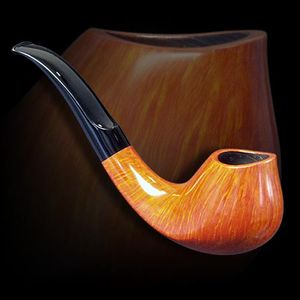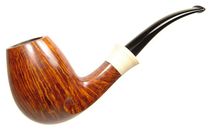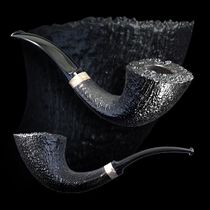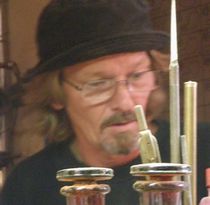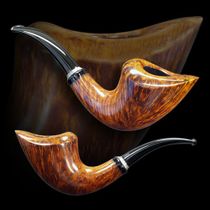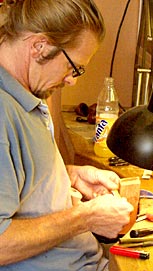Nielsen, Tonni
Tonni has been making pipes ever since the age of 16. With the mentors Former and Teddy Knudsen he had a good start making pipes for W.O. Larsen in the early 70’s.
Tonni lives with his family in USA and today he is among the best pipe makers in the world. He finds his inspiration in nature – his recent shape “the Walnut” is a fine example of this.
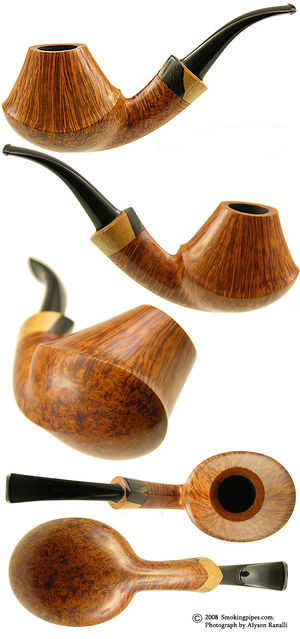
Tonni describes his own background:
My name is Tonni Nielsen. I was born in Copenhagen, Denmark in 1953. When I was 16 years old, I started working for W.Ø. Larsen. After 2 or 3 years, I started making Fancy and Straight Grain pipes of my own design at Larsen. I worked with Teddy Knudsen and Former (Hans Nielsen) amongst others. I also taught a number of pipe makers how to make pipes. Then in 1978 I started my own business and sold pipes around the world. At that point I sold pipes to W. Ø. Larsen and under my own name. In 1983 I moved to United States with my American wife and our two children. I have a pipe workshop in the basement of our home. Pipe making is so solitary that I also began playing tennis to get out of the house. That lead me to becoming a teaching pro. I enjoy both making pipes and teaching tennis.
I was going to be a toolmaker, but decided against it for various reasons. Then I got a job at W. Ø. Larsen and after about 3 years, I had my own production of fancy pipes at Larsen. From then on, I began to realize that I had a future as a pipe maker.
Yes, there have been several pipe makers who have either helped or inspired me. Of course, Hans Nielsen (Former) and Teddy Knudsen were my mentors. Many pipe makers have been a great inspiration for me like Poul Ilsted, Jess Chonowitsch, Bo Nordh, Sixten Ivarsson and Lars Ivarsson among others.
I always work with the highest quality briar. Mostly, I am working with briar from Corsica and sometimes from Greece. For my mouthpieces, I use ebonite, cultured amber, or boxwood. As adornment to the pipe, between the stem and bowl, I use many exotic woods like boxwood, zebrawood, cocabolo, ziricate, ebony, tagau nut, and other materials.
The grains are just about everything. The size of the block is also important, because you want enough material so you can turn the pipe so that it follows the grains. Then of course, the ”cleanness” or lack of imperfections in the briarwood is important too.
The mouthpiece is extremely important. It is at least 50% of the pipe. Let us say that you make the perfect pipe, but put a clumsy stem that does not really compliment the pipe, then the pipe is just practically worthless. If you turn the picture, and have a boring piece of briar, but you make a nice shape and then make a really nice stem, and you’ll end up with a nice pipe. Here are a few points:
1) Bending the stem balances the pipe. 2) The bit has to be 4mm thin and narrow so that it is comfortable in your mouth. 3) The stem has to have the same finish as the pipe.
Inspiration comes from many places such as walks in nature. In the woods where you see tree branches and roots sticking up out of the ground give me different ideas. At the beach, I see rocks, stones, and sea animals washing up on the shore and I develop many of my ideas from this.
Over the years I have gotten better technically, and this gives me confidence to follow my ideas, and I think that it gives me even more ideas.
Coming up with new ideas and doing the rough shaping. Then to finish them and seeing the result, that is the ultimate thrill.
I demand perfection on my expensive as well as my less expensive pipes. I also think that my shapes are uniquely my own.
I am planning to make pipes for the rest of my life, whatever that means.
The briar root is a material of incredible beauty. Most briar has imperfections, but those imperfections do not really take away from the beauty of the wood. I appreciate the perfect briar pieces as well as those with naturally occurring imperfections.
Offsite Links
- Listen to Brian Levine's interview with Tonni on the PipesMagazine Radio Show
- An excellent article on Tonni and his work appears at Tobaccodays.com
Contact information:
You can get in touch with Tonni at the following address - or you can contact him through danishpipemakers.com: Tonni Nielsen 9306 Plumwood Place Crestwood, KY 40014 USA E-mail: mailto:thenielsens4@hotmail.com
The basis of this article uses materials from danishpipemakers.com[1] materials, with kind permission.
